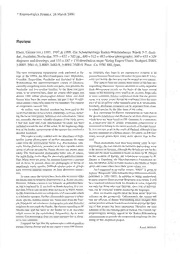
Review: Die Schmetterlinge Baden-Württembergs PDF
Preview Review: Die Schmetterlinge Baden-Württembergs
Entomologica Fennica. 24 March 2000 © Review Ebert, Gunter (ed.) 1997, 1997 & 1998: Die Schmetterlinge Baden-Wtirttembergs. Bande 5-7. Sesii dae, Arctiidae, Noctuidae. 575 + 622 + 582 pp., 400 + 512 + 483 colour photographs, 360 + 433 + 329 diagrams and drawings, and 133 + 187 + 170 distribution maps. Verlag Eugen Ulmer. Stuttgart. ISBN 3-8001-3481-0, 3-8001-3482-9, 3-8001-3500-0. Price: Ca. FIM 480,-/part. The most monumental lepidopteran work published in Eu ny. Similarly, they hope to see reproductive isolation to be rope in the 1990s, the Macrolepidoptera (incl. Hepialidae, proved between Diachrysia (clllysitis) ch1ysitis and D. (cluy Cossidae, Zygaenidae, Psychidae and Sesiidae) of Baden sitis) tutti before the two taxa can be treated as two species. Wiirttemberg, the southwesternmost county of Germany, The authors have not always been aware of the best dis currently comprising seven brick-size parts, now presents the tinguishing characters: Apamea unanimis is easily separable Noctuidae and two smaller families. In the three last parts from Mesapamea secalis on the basis of the large central alone, to be reviewed here, there are almost 1800 pages and lunule of the hindwing (very small in M. seca/is). Especially almost 1400 colour photographs! Giinter Ebert and Axel in worn condition, Eilema complanum (note that the generic Steiner have been the main authors, but part 5 had 15 addi name is a neuter noun) should be confirmed from the pres tional authors (especially many for the Sesiidae). The number ence of an all-yellow collar (medially grey in E. lurideolum). of cooperators exceeds 200. Similarly, Mythimna straminea can be separated from close As earlier, very detailed attention has been paid to the ly related species by the lilac lines of the collar. local observations on occurrence, phenology, ecology, includ It is interesting for Finnish lepidopterists to note that in ing the larval food plants, behaviour and conservation. These the genera Amphipoea and Hydraecia we have three species are, naturally, the most valuable chapters of the book series. which have not been found in SW Germany, A. crinanensis, I feel that more and more international literature has been H. nordstroemi and H. ultima. Eremobina pabulatricula is included toward the end of the series. In the beginning chap considered to belong to the rarest noctuids of Europe (usual ters of the books, conservation of the species has received a ly, it is not rare at all in the south of Finland, although it has detailed treatment. recently experienced a bottom phase). Of course, in SW Ger The reader is really coddled with the abundance of high many, several genera have many more species than in Fin quality colour photographs of perfect specimens. In many land. cases even the polymorphic forms (e.g. Brachylomia vimi These monuments have their long-lasting value. In lepi nalis, Noctuafimbriata, pronuba) or at least variable colour dopterology, the real classics on faunistics and ecology seem ations (Cybosia mesomella, Euxoa decora) are shown sepa to be written in German, although the British are not far be rately. The flash-assisted photographs better suit, of course, hind and the more taxonomical books as those by M. Fibiger the night-flying moths than the previously published butter on the noctuids of Europe, the voluminous revisions by H. flies. Many shots are great, for instance Lamprotes c-aureum Hacker in Esperiana, the Microlepidoptera Palaearctica se and its larva. In general, there are photographs of larvae of ries, the MONA series in North America, the Moths of Nepal surprisingly many species. Difficult species pairs or groups series and some others have their great values, too. have received separate chapters on their distinctive charac As I suggested in an earlier review, "Ebert" is going to ters. replace "Bergmann" (Die Schmetterlinge Mille/deutschlands, In some cases the writers have been able to correct older published in 1951-1955). In addition to being modernized, erroneous data on holarctic distributions (e.g. Xestia sincera). in many respects Ebert exceeds Bergmann in accuracy. It will However, Schinia scutosa is not holarctic as published here be a standard reference book for decades to come, hopefully in, but is replaced by S. nucha/is in North America. It is cor not only for those who read German, since lots of informa rect that Po/ychrysia moneta does not occur in Nmth Ameri tion can be extracted without mastering the language. ca (the American trabea is a subspecies of P. esmeralda which Now we readers eagerly await the book series' final two is a holarctic species). Further, Parastichtis suspecta is a hoi volumes on the geometrids. Unfortunately, the rumors tell arctic species, Xanthia toga/a not. Some data from the East that the officials of Baden-Wiirttemberg have changed their em Palaearctic are erroneous: Autographa jota and He/iothis earlier positive attitude toward conservation and that the fund viriplaca do not reach the Pacific, the former extending toW ing of this project has been interrupted. Therefore the time Siberia only and the latter to the Baikal (it is H. maritima schedule of the two missing parts is unclear. The Finnish lep which occurs in the easternmost Palaearctic ). As is well idopterologists strongly appeal to the Baden-Wiirttemberg known, Czechoslovakia does not exist anymore but is divid administration to provide the economical conditions for fin ed to two countries. ishing of this important project. I enjoyed the fact that the authors take a critical position toward Diarsiajlorida and do not report it from SW Genna- Kauri Mikkola
